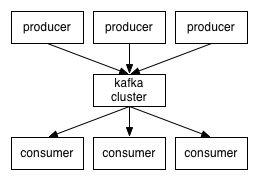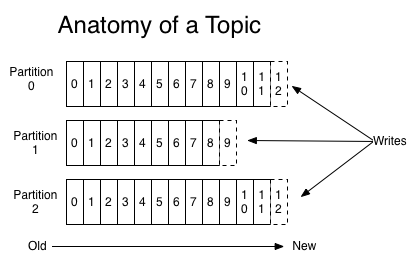http://kafka.apache.org/documentation.html
1.1 Introduction
Kafka is a distributed, partitioned, replicated commit log service. It provides the functionality of a messaging system, but with a unique design.
What does all that mean?
First let's review some basic messaging terminology:
- Kafka maintains feeds of messages in categories called topics.
- We'll call processes that publish messages to a Kafka topic producers.
- We'll call processes that subscribe to topics and process the feed of published messages consumers..
- Kafka is run as a cluster comprised of one or more servers each of which is called a broker.
So, at a high level, producers send messages over the network to the Kafka cluster which in turn serves them up to consumers like this:

Communication between the clients and the servers is done with a simple, high-performance, language agnostic TCP protocol. We provide a Java client for Kafka, but clients are available in many languages.
Topics and Logs
Let's first dive into the high-level abstraction Kafka provides—the topic.
A topic is a category or feed name to which messages are published. For each topic, the Kafka cluster maintains a partitioned log that looks like this:

Each partition is an ordered, immutable sequence of messages that is continually appended to—a commit log. The messages in the partitions are each assigned a sequential id number called the offset that uniquely identifies each message within the partition.
The Kafka cluster retains all published messages—whether or not they have been consumed—for a configurable period of time. For example if the log retention is set to two days, then for the two days after a message is published it is available for consumption, after which it will be discarded to free up space. Kafka's performance is effectively constant with respect to data size so retaining lots of data is not a problem.
In fact the only metadata retained on a per-consumer basis is the position of the consumer in the log, called the "offset". This offset is controlled by the consumer: normally a consumer will advance its offset linearly as it reads messages, but in fact the position is controlled by the consumer and it can consume messages in any order it likes. For example a consumer can reset to an older offset to reprocess.
This combination of features means that Kafka consumers are very cheap—they can come and go without much impact on the cluster or on other consumers. For example, you can use our command line tools to "tail" the contents of any topic without changing what is consumed by any existing consumers.
The partitions in the log serve several purposes. First, they allow the log to scale beyond a size that will fit on a single server. Each individual partition must fit on the servers that host it, but a topic may have many partitions so it can handle an arbitrary amount of data. Second they act as the unit of parallelism—more on that in a bit.
Distribution
The partitions of the log are distributed over the servers in the Kafka cluster with each server handling data and requests for a share of the partitions. Each partition is replicated across a configurable number of servers for fault tolerance.
Each partition has one server which acts as the "leader" and zero or more servers which act as "followers". The leader handles all read and write requests for the partition while the followers passively replicate the leader. If the leader fails, one of the followers will automatically become the new leader. Each server acts as a leader for some of its partitions and a follower for others so load is well balanced within the cluster.
Producers
Producers publish data to the topics of their choice. The producer is responsible for choosing which message to assign to which partition within the topic. This can be done in a round-robin fashion simply to balance load or it can be done according to some semantic partition function (say based on some key in the message). More on the use of partitioning in a second.
Consumers
Messaging traditionally has two models: queuing and publish-subscribe. In a queue, a pool of consumers may read from a server and each message goes to one of them; in publish-subscribe the message is broadcast to all consumers. Kafka offers a single consumer abstraction that generalizes both of these—the consumer group.
Consumers label themselves with a consumer group name, and each message published to a topic is delivered to one consumer instance within each subscribing consumer group. Consumer instances can be in separate processes or on separate machines.
If all the consumer instances have the same consumer group, then this works just like a traditional queue balancing load over the consumers.
If all the consumer instances have different consumer groups, then this works like publish-subscribe and all messages are broadcast to all consumers.
More commonly, however, we have found that topics have a small number of consumer groups, one for each "logical subscriber". Each group is composed of many consumer instances for scalability and fault tolerance. This is nothing more than publish-subscribe semantics where the subscriber is cluster of consumers instead of a single process.
Kafka has stronger ordering guarantees than a traditional messaging system, too.

A two server Kafka cluster hosting four partitions (P0-P3) with two consumer groups. Consumer group A has two consumer instances and group B has four.
A traditional queue retains messages in-order on the server, and if multiple consumers consume from the queue then the server hands out messages in the order they are stored. However, although the server hands out messages in order, the messages are delivered asynchronously to consumers, so they may arrive out of order on different consumers. This effectively means the ordering of the messages is lost in the presence of parallel consumption. Messaging systems often work around this by having a notion of "exclusive consumer" that allows only one process to consume from a queue, but of course this means that there is no parallelism in processing.
Kafka does it better. By having a notion of parallelism—the partition—within the topics, Kafka is able to provide both ordering guarantees and load balancing over a pool of consumer processes. This is achieved by assigning the partitions in the topic to the consumers in the consumer group so that each partition is consumed by exactly one consumer in the group. By doing this we ensure that the consumer is the only reader of that partition and consumes the data in order. Since there are many partitions this still balances the load over many consumer instances. Note however that there cannot be more consumer instances than partitions.
Kafka only provides a total order over messages within a partition, not between different partitions in a topic. Per-partition ordering combined with the ability to partition data by key is sufficient for most applications. However, if you require a total order over messages this can be achieved with a topic that has only one partition, though this will mean only one consumer process.
Guarantees
At a high-level Kafka gives the following guarantees:
- Messages sent by a producer to a particular topic partition will be appended in the order they are sent. That is, if a message M1 is sent by the same producer as a message M2, and M1 is sent first, then M1 will have a lower offset than M2 and appear earlier in the log.
- A consumer instance sees messages in the order they are stored in the log.
- For a topic with replication factor N, we will tolerate up to N-1 server failures without losing any messages committed to the log.
More details on these guarantees are given in the design section of the documentation.
1.2 Use Cases
Here is a description of a few of the popular use cases for Apache Kafka. For an overview of a number of these areas in action, see this blog post.
Messaging
Kafka works well as a replacement for a more traditional message broker. Message brokers are used for a variety of reasons (to decouple processing from data producers, to buffer unprocessed messages, etc). In comparison to most messaging systems Kafka has better throughput, built-in partitioning, replication, and fault-tolerance which makes it a good solution for large scale message processing applications.
In our experience messaging uses are often comparatively low-throughput, but may require low end-to-end latency and often depend on the strong durability guarantees Kafka provides.
In this domain Kafka is comparable to traditional messaging systems such as ActiveMQ or RabbitMQ.
Website Activity Tracking
The original use case for Kafka was to be able to rebuild a user activity tracking pipeline as a set of real-time publish-subscribe feeds. This means site activity (page views, searches, or other actions users may take) is published to central topics with one topic per activity type. These feeds are available for subscription for a range of use cases including real-time processing, real-time monitoring, and loading into Hadoop or offline data warehousing systems for offline processing and reporting.
Activity tracking is often very high volume as many activity messages are generated for each user page view.
Metrics
Kafka is often used for operational monitoring data. This involves aggregating statistics from distributed applications to produce centralized feeds of operational data.
Log Aggregation
Many people use Kafka as a replacement for a log aggregation solution. Log aggregation typically collects physical log files off servers and puts them in a central place (a file server or HDFS perhaps) for processing. Kafka abstracts away the details of files and gives a cleaner abstraction of log or event data as a stream of messages. This allows for lower-latency processing and easier support for multiple data sources and distributed data consumption. In comparison to log-centric systems like Scribe or Flume, Kafka offers equally good performance, stronger durability guarantees due to replication, and much lower end-to-end latency.
Stream Processing
Many users end up doing stage-wise processing of data where data is consumed from topics of raw data and then aggregated, enriched, or otherwise transformed into new Kafka topics for further consumption. For example a processing flow for article recommendation might crawl article content from RSS feeds and publish it to an "articles" topic; further processing might help normalize or deduplicate this content to a topic of cleaned article content; a final stage might attempt to match this content to users. This creates a graph of real-time data flow out of the individual topics. Storm and Samza are popular frameworks for implementing these kinds of transformations.
Event Sourcing
Event sourcing is a style of application design where state changes are logged as a time-ordered sequence of records. Kafka's support for very large stored log data makes it an excellent backend for an application built in this style.
Commit Log
Kafka can serve as a kind of external commit-log for a distributed system. The log helps replicate data between nodes and acts as a re-syncing mechanism for failed nodes to restore their data. The log compaction feature in Kafka helps support this usage. In this usage Kafka is similar to Apache BookKeeper project.







相关推荐
Kafka 0.8.1 是 Apache Kafka 的一个重要版本,它是一个分布式流处理平台,用于构建实时数据管道和流应用。这个版本在 Kafka 的发展史上占据着关键地位,因为它引入了多项改进和新特性,旨在提升性能、稳定性和可...
搭建storm+kafka+zookeeper环境所需要的三个环境组件,里面的参数已经配置完成,你只需要把对应的集群的ipHost换成你搭建的ip即可,已经成功搭建并测试,如果有疑问可以访问本人的博客,里面有详细的配置可供参考
Apache Kafka是一个分布式流处理平台,用于构建实时数据管道和流应用程序。它由LinkedIn公司开发,并于2011年开源。Kafka具有高吞吐量、可扩展性和可靠性等特点,能够处理大量数据,并支持多个生产者和消费者。 ...
Apache Kafka 是一个分布式流处理平台,由LinkedIn 开发并捐赠给了Apache 软件基金会,现在已成为大数据领域的重要组件。Kafka 主要用于构建实时数据管道和流应用,它能够高效地处理大量的实时数据,同时提供了消息...
storm0.9.1+kafka0.8.1.1亲测可以跑起来的工程,有些乱,我后续继续整理 kafka0.8Storm0.9.1Optr/com.ks.topoloty.CounterTopology.java是启动主文件 Kafka0.8Optr2/SendMessage.java是测试文件 可以在kafka0.8Storm...
《Kafka 2.9.2-0.8.1:分布式消息系统详解》 Apache Kafka 是一个开源的分布式流处理平台,最初由 LinkedIn 开发并贡献给 Apache 软件基金会。它被设计为一个高吞吐量、低延迟的消息传递系统,支持发布和订阅模式的...
**Apache Kafka 中文文档概述** Apache Kafka 是一个开源的分布式流处理平台,由LinkedIn开发并在2011年开源,随后被Apache软件基金会接纳为顶级项目。Kafka设计目标是成为一个高吞吐量、低延迟的消息发布与订阅...
To download the Kafka UI Tool for your operating system, use the links below. All versions of Kafka Tool come with a bundled JRE with the ...Kafka Tool supports Apache Kafka ® version 0.8.1 and above.
Apache Kafka 是一个分布式流处理平台,由LinkedIn 开发并捐赠给了Apache 软件基金会。Kafka 主要设计目标是构建实时数据管道和流应用,它具有高吞吐量、低延迟、容错性强和可扩展性好等特点。在本文中,我们将深入...
**Kafka Tool 连接 Kafka 工具详解** 在大数据处理和实时流处理领域,Apache Kafka 是一个不可或缺的组件,它作为一个分布式的消息中间件,提供高效、可扩展且可靠的发布订阅服务。为了方便管理和操作 Kafka 集群,...
**Kafka Tool:高效管理Apache Kafka集群的利器** Apache Kafka是一个分布式的流处理平台,广泛应用于大数据实时处理、日志聚合、消息系统等多个领域。在Kafka的实际操作中,管理和监控集群是至关重要的任务,而...
本文档详细介绍了如何搭建一个基于Kafka 0.8.1版本的集群,并且演示了如何进行基本的集群管理和消息收发操作。通过上述步骤,用户可以轻松地部署一个稳定可靠的Kafka集群,为后续的数据处理和分析打下坚实的基础。
在IT行业中,Kafka是一种广泛使用的分布式流处理平台,它由Apache软件基金会开发,主要用于构建实时数据管道和流应用。本文将围绕标题和描述中提到的两种Kafka工具——kafkatool-64bit.exe和kafka-eagle-bin-1.4.6....
**Kafka工具详解——Kafkatool** Kafka作为一个分布式流处理平台,广泛应用于大数据实时处理和消息传递。然而,管理Kafka集群和操作其组件(如topics、partitions、offsets等)可能会变得复杂,这时就需要一些可视...